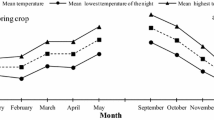Summary
Competition between sprouting eyes for mother tuber reserves (as determined by sprout dry-weight accumulation) was eliminated by incubating tubers in perlite watered with a complete nutrient solution. The importance of N, P and K in the alleviation of competition was established by the selective omission of individual components of the solution. However, within an eye the number of branch sprouts was reduced by an increase in the number of sprouting eyes per tuber and this response was not influenced by supplying exogenous mineral ions.
Zusammenfassung
Calzium förderte das Symptom einer subapikalen Spitzennekrose an wachsenden Keimen, verminderte als Sulfatsalz appliziert jedoch nicht die Konkurrenzwirkung zwischen Keimen für Reserven der Mutterknolle; die Keim-Trockengewichts-Akkumulation pro Auge war beispielweise durch eine höhere Zahl keimender Augen je Knolle noch stärker reduziert (Abb. 1 und 2). Die Konkurrenzwirkung reduzierte sich durch Zufuhr von exogenem NO3-N und wurde durch komplette Nährlösung verhindert. Die Bedeutung von N, P und K für die Konkurrenzminderung und eine optimierende Wachstumsverlängerung ergab sich aus dem selektiven Auslassen individueller Komponentender Lösung (Abb. 3 und 4). Beim Wachstum ergaben sich keine signifikanten Effekte wenn Mg, Fe und Spurenelemente aus dem Wachstumsmedium herausgenommen wurden. Dosis-Wirkungs-Kurven für Wachstum bei mehreren Calzium- und Stickstoff-Dosierungen zeigten, dass sich optimale Wachstumsraten ergaben wenn diese Elementen bei einer Konzentration von 10 mmol/l vorhanden waren. Signifikante Wachstumsreduktionen ergaben sich bei Senkung der NO3-N-Konzentration auf 1 mmol/l (Abb. 5). Gleiches ergab sich bei Calzium durch Senkung der Konzentration auf 0,1 mmol/l (Abb. 6 und 7).
Résumé
Le calcium réduit l'apparition de nécroses subapicales de germes en croissance mais, apporté sous forme de sulfate, ne diminue pas la compétition entre les germes pour l'utilisation des réserves du tubercule mère. C'est-à-dire que l'accumulation de poids sec des germes par oeil était toujours sévèrement abaissée par une augmentation du nombre d'yeux par tubercule (fig. 1 et 2). La compétition est réduite par l'apport de NO3-N exogène et éliminée avec une solution nutritive complète. L'importance de N, P et K dans la diminution de la compétition et l'optimisation de la croissance en longueur est établie par l'omission individuelle et sélective de certains composants de la solution (fig. 3 et 4). Les absences de Mg, Fe et microéléments du milieu nutritif sont sans effet sur la croissance. Les courbes de réponse à la dose avec différents niveaux de calcium et d'azote montrent que les vitesses optimales de croissance sont établies quand ces éléments sont présents à la concentration de 10 mmol/l. Des réductions significatives de la croissance apparaissent lorsque la concentration en NO3-N est abaissée jusqu'à 1 mmol/l (fig. 5). En ce qui concerne le calcium, l'effet est marqué lorsque la concentration est réduite à 0,1 mmol/l (fig. 6 et 7).
Similar content being viewed by others
References
Crooke, W. M. & W. E. Simpson, 1971. Determination of ammonium in Kjeldahl digests of crops by an automated procedure.Journal of the Science of Food and Agriculture 22: 9–10.
Davies, H. V., 1984. Mother tuber reserves as factors limiting sprout growth.Potato Research 27: 209–218.
Dinkel, D. H., 1968. Nitrogen metabolism of potato tubers: assimilation of stored tuber reserves in the light and dark.Proceedings of the American Society of Horticultural Science 93: 476–484.
Dyson, P. W. & J. Digby, 1975. Effect of calcium on sprout growth and sub-apical necrosis in Majestic potatoes.Potato Research 18: 290–305.
Fong, K. H. & A. Ulrich, 1970. Calcium nutrition of White Rose potato in relation to growth and leaf minerals.Communications in Soil Science and Plant Analysis 1: 43–55.
Headford, D. W. R., 1961. Sprout growth of the potato. Ph.D. Thesis, University of Nottingham.
Headford, D. W. R., 1962. Sprout development and subsequent plant growth.European Potato Journal 5: 14–22.
Kirkham, M. B., D. R. Keeney & W. R. Gardner, 1974. Uptake of water and labelled nitrate at different depths in the root zone of potato plants grown on a sandy soil.Agro-Ecosystems 1: 31–44.
Krauss, A., 1978. Tuberisation and abscisic acid content inSolanum tuberosum as affected by nitrogen nutrition.Potato Research 21: 183–193.
McCown, D. D. & D. H. Dinkel, 1974. Shoot inhibition inSolanum tuberosum. I. Response to ammonium and nitrate nitrogen sources.American Potato Journal 51: 223–228.
Moorby, J., 1967. Inter-stem and inter-tuber competition in potatoes.European Potato Journal 10: 189–205.
Morris, D. A., 1966. Inter-sprout competition in the potato. 1. Effect of tuber size, sprout number and temperature on sprout growth during storage.European Potato Journal 9: 69–85.
Morris, D. A., 1967. Inter-sprout competition in the potato. 2. Competition for nutrients during pre-emergence growth after planting.European Potato Journal 10: 296–311.
Polizotto, K. R., G. E. Wilcox & C. M. Jones, 1975. Response of growth and mineral composition of potato to nitrate and ammonium nitrogen.Journal of the American Society of Horticultural Science 100: 165–168.
Sadler, E., 1961. Factors influencing the development of sprouts of the potato. Ph.D. Thesis, University of Nottingham.
Ulrich, A. & K. H. Fong, 1970. Phosphorus nutrition of White Rose potato in relation to growth and minerals of leaf and root tissues.Communications in Soil Science and Plant Analysis 1: 141–154.
Ulrich, A. & K. H. Fong, 1973. Nitrogen nutrition of White Rose potato in relation to vegetative growth and mineral content of leaves and roots.Communications in Soil Science and Plant Analysis 4: 413–426.
Author information
Authors and Affiliations
Rights and permissions
About this article
Cite this article
Davies, H.V., Ross, H.A. The effects of mineral nutrition on inter-sprout competition in cv. Maris Piper. Potato Res 28, 43–53 (1985). https://doi.org/10.1007/BF02357569
Accepted:
Issue Date:
DOI: https://doi.org/10.1007/BF02357569



